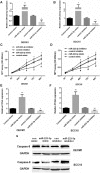MiR-223 promotes oral squamous cell carcinoma proliferation and migration by regulating FBXW7
- PMID: 30883339
- PMCID: PMC6484253
- DOI: 10.3233/CBM-181877
MiR-223 promotes oral squamous cell carcinoma proliferation and migration by regulating FBXW7
Abstract
Abnormally expressed microRNAs (miRNAs) contribute widely to human cancer, including oral squamous cell carcinoma (OSCC), by regulating their downstream targets. MiR-223 has been proved to be up-regulated in both gastric cancer and ovarian cancer. However, the effect of miR-223 on OSCC is still unclear. Here, we showed that miR-223 was over-expressed in OSCC tissues using qRT-PCR. Next, we investigated the biological mechanism of miR-223 in OSCC. The results demonstrated that miR-223 facilitated the cell proliferation and migration of OSCC using MTT assay and Transwell assay. Furthermore, we stated that the FBXW7 expression was decreased in OSCC and re-expression of FBXW7 inhibited the proliferation and migration of OSCC. In addition, FBXW7 mimic inversed the promotion effect of miR-223 in regulating of OSCC cells. In short, miR-223 promoted OSCC cell proliferation and migration by downregulating FBXW7, which provided a novel therapeutic strategy for OSCC.
Keywords: FBXW7; MiR-223; OSCC; migration; proliferation.
Conflict of interest statement
No conflicts declared.
Figures





Similar articles
-
FBXW7 inhibited cell proliferation and invasion regulated by miR-27a through PI3K/AKT signaling pathway and epithelial-to-mesenchymal transition in oral squamous cell carcinoma.Eur Rev Med Pharmacol Sci. 2020 Apr;24(7):3701-3709. doi: 10.26355/eurrev_202004_20833. Eur Rev Med Pharmacol Sci. 2020. PMID: 32329846
-
MiR-376c-3p regulates the proliferation, invasion, migration, cell cycle and apoptosis of human oral squamous cancer cells by suppressing HOXB7.Biomed Pharmacother. 2017 Jul;91:517-525. doi: 10.1016/j.biopha.2017.04.050. Epub 2017 May 5. Biomed Pharmacother. 2017. PMID: 28482289
-
MiR-375/SLC7A11 axis regulates oral squamous cell carcinoma proliferation and invasion.Cancer Med. 2017 Jul;6(7):1686-1697. doi: 10.1002/cam4.1110. Epub 2017 Jun 19. Cancer Med. 2017. PMID: 28627030 Free PMC article.
-
World Workshop on Oral Medicine VII: Functional pathways involving differentially expressed lncRNAs in oral squamous cell carcinoma.Oral Dis. 2019 Jun;25 Suppl 1:79-87. doi: 10.1111/odi.13051. Oral Dis. 2019. PMID: 31140691 Review.
-
Epithelial-mesenchymal transition and microRNAs: Challenges and future perspectives in oral cancer.Head Neck. 2018 Oct;40(10):2304-2313. doi: 10.1002/hed.25381. Epub 2018 Aug 18. Head Neck. 2018. PMID: 30120853 Review.
Cited by
-
Identification and bioinformatic characterization of a serum miRNA signature for early detection of laryngeal squamous cell carcinoma.J Transl Med. 2024 Jul 10;22(1):647. doi: 10.1186/s12967-024-05385-3. J Transl Med. 2024. PMID: 38987822 Free PMC article.
-
LncRNA MAGI2-AS3 inhibits the self-renewal of leukaemic stem cells by promoting TET2-dependent DNA demethylation of the LRIG1 promoter in acute myeloid leukaemia.RNA Biol. 2020 Jun;17(6):784-793. doi: 10.1080/15476286.2020.1726637. Epub 2020 Mar 15. RNA Biol. 2020. PMID: 32174258 Free PMC article.
-
MiRNA-related metastasis in oral cancer: moving and shaking.Cancer Cell Int. 2023 Aug 27;23(1):182. doi: 10.1186/s12935-023-03022-5. Cancer Cell Int. 2023. PMID: 37635248 Free PMC article. Review.
-
Insight toward the MicroRNA Profiling of Laryngeal Cancers: Biological Role and Clinical Impact.Int J Mol Sci. 2020 May 24;21(10):3693. doi: 10.3390/ijms21103693. Int J Mol Sci. 2020. PMID: 32456271 Free PMC article. Review.
-
Non-Coding RNAs in Oral Cancer: Emerging Roles and Clinical Applications.Cancers (Basel). 2023 Jul 25;15(15):3752. doi: 10.3390/cancers15153752. Cancers (Basel). 2023. PMID: 37568568 Free PMC article. Review.
References
-
- Jornet P.L., Garcia F.J., Berdugo M.L., Perez F.P. and Lopez A.P., Mouth self-examination in a population at risk of oral cancer, Australian Dental Journal 60 (2015), 59–64. - PubMed
-
- Lo W.L., Kao S.Y., Chi L.Y., Wong Y.K. and Chang R.C., Outcomes of oral squamous cell carcinoma in Taiwan after surgical therapy: factors affecting survival, Journal of Oral and Maxillofacial Surgery: Official Journal of the American Association of Oral and Maxillofacial Surgeons 61 (2003), 751–758. - PubMed
-
- Huntzinger E. and Izaurralde E., Gene silencing by microRNAs: contributions of translational repression and mRNA decay, Nature Reviews Genetics 12 (2011), 99–110. - PubMed
-
- Fu S., Chen H.H., Cheng P., Zhang C.B. and Wu Y., MiR-155 regulates oral squamous cell carcinoma Tca8113 cell proliferation, cycle, and apoptosis via regulating p27Kip1, European Review for Medical and Pharmacological Sciences 21 (2017), 937–944. - PubMed
MeSH terms
Substances
LinkOut - more resources
Full Text Sources
Other Literature Sources
Medical

